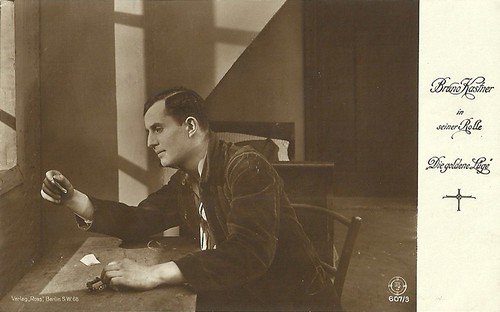Die goldene Lüge (1919)

German postcard by Ross Verlag, no. 607/1. Photo: Ring-Film. Bruno Kastner and Ria Jende in the German silent film Die goldene Lüge/The Golden Lie (Erik Lund, 1919).

German postcard by Ross Verlag, no. 607/2. Photo: Ring-Film. Bruno Kastner in Die goldene Lüge/The Golden Lie (Erik Lund, 1919).
Die goldene Lüge/The Golden Lie (1919) Bruno Kastner plays Ralf Sporeck, the son of a count in great debt. He marries a banker's daughter (Ria Jende). When he finds out he isn't a count at all, he wants to leave.
The film was scripted by Georg Kaiser and cinematographed by Curt Courant. Sets may have been by Siegfried Wroblewsky. Leopold von Ledebur played either the old count or the banker. In April 1919 the film was screened at the Berlin Tauentzienpalast.

German postcard by Ross Verlag, no. 607/3. Photo: Ring-Film. Bruno Kastner in Die goldene Lüge/The Golden Lie (Erik Lund, 1919).

German postcard by Ross Verlag, no. 607/4. Photo: Ring-Film. Bruno Kastner and Ria Jende in the German silent film Die goldene Lüge/The Golden Lie (Erik Lund, 1919).
Die Bodega von Los Cuerros (1919)

German postcard by Ross Verlag, no. 617/1. Photo: Ring Film. Bruno Kastner in Die Bodega von Los Cuerros/The Bodega of Los Cuerros (Erik Lund, 1919).

German postcard by Ross Verlag, no. 617/2. Photo: Ring Film. Bruno Kastner (left) in Die Bodega von Los Cuerros/The Bodega of Los Cuerros (Erik Lund, 1919).
Die Bodega von Los Cuerros/The Bodega of Los Cuerros (1919) was directed by Erik Lund, scripted by Ruth Goetz and cinematographed by Curt Courant. Little is known about this film, starring Bruno Kastner and costarring Ria Jende, Leopold von Ledebur, Rosa Liechtenstein, Paul Biensfeldt, Hermann Picha and others, must have been a crime and adventure film, possibly with Kastner as a detective. The film premiered in Berlin on 2 August 1919, so half a year after the armistice that ended the First World War.
Director Erik Lund was born Manfred Liebenau in Berlin in 1893. He began his career as an architect before being engaged by director-producer Joe May as manager. In 1918 he founded the company Ring-Film GmbH and became its producer. In the same year, Lund married May's daughter Eva May and also became film director at Ring-Film. The first films of Ring-Film such as Erträumtes (1918) with Eva May were still directed by Adolf Gärtner, but quite soon Lund became co-director or sole director.
Ring Film flourished in the years 1918-1921. From 1918 Lund directed many films with his wife Eva May, such as Sadja (1918), Staatsanwalt Jordan (1919), Die verwunschene Prinzessin (1919), Das törichte Herz (1919), and Die Fee von Saint Ménard (1919). From 1919 many of the scripts for Ring-Film were written by Ruth Goetz, while Curt Courant was the regular cinematographer.
From 1919 Lund also directed the beloved male star Bruno Kastner in many films, such as Die Bodega von Los Cuerros (1919), Die goldene Lüge (1919), and Das Herz des Casanova (1919). For many of those films, he was also responsible as the producer, and for a few of them, he also wrote the screenplay. In the early 1920s, he made his last films as director, e.g. Präsident Barrada (1920) with Michael Bohnen, but most were with Bruno Kastner in the lead, such as Weisse Rosen (1920), the serial film Der Silberkönig (1921), Der bekannte Unbekannte (1922), and Das Geheimnis von Schloss Ronay (1922). The latter two were produced by Kastner's own film company Kastner Film.
From 1921, Lund worked for Delta Film, Kastner Film, and Ring-Film AG, not to be confused with Lund's former company. Ring-Film AG is mostly known for the Harry Piel films of 1927-1928. Apart from a last producer's job with Ring-Film AG, the period piece Götz von Berlingen (1925) starring Eugen Klöpfer, Lund did not work in film after 1922. From 1930 Lund retook his work in the German - by now sound - film industry, but now as production manager and under his original name, e.g. for Das Land des Lächelns (Max Reichmann, 1930) and Die große Attraktion (Max Reichmann, 1931). After 1931 Lund definitely left the German film world. It is unknown where and when he died.

German postcard by Ross Verlag, no. 617/4. Photo: Ring Film. Bruno Kastner and Ria Jende in Die Bodega von Los Cuerros/The Bodega of Los Cuerros (Erik Lund, 1919). The man in the middle could well be Leopold von Ledebur.
Artistentreue (1919)

German postcard by Ross Verlag, no. 618/1. Photo: Ring-Film. Bruno Kastner in Artistentreue/Devoted Artists (Erik Lund, 1919).

German postcard by Ross Verlag, no. 618/2. Photo: Ring-Film. Bruno Kastner and Hanne Brinkmann in Artistentreue/Devoted Artists (Erik Lund, 1919).
John Lind, a presumed cousin (Leopold von Ledebur) of a count (Karl von Platen), abducts the count's daughter (Hanne Brinkmann), but he is unmasked by circus artist James (Bruno Kastner). The hero gets the girl as a reward.
Artistentreue (1919) was scripted by Georg Kaiser, cinematographed by Curt Courant, while sets were (probably) by Siegfried Wroblewsky. The film premiered at the Berlin cinema Biophon in December 1919.

German postcard by Ross Verlag, no. 618/3. Photo: Ring-Film. Bruno Kastner and Hanne Brinkmann in Artistentreue/Devoted Artists (Erik Lund, 1919).

German postcard by Ross Verlag, no. 618/4. Photo: Ring-Film. Bruno Kastner and Hanne Brinkmann in Artistentreue/Devoted Artists (Erik Lund, 1919).
Sources: Early Cinema, Wikipedia (German and English) and IMDb.
No comments:
Post a Comment